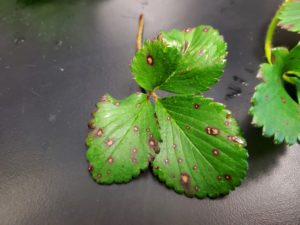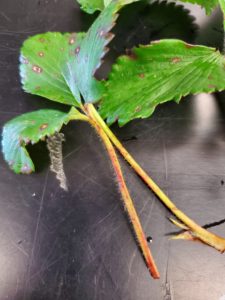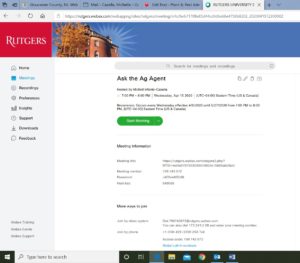Strawberry leaf spot, caused by the soil-borne fungal pathogen, Mycosphaerella fragariae, has been found in some strawberry fields on some cultivars this past week in southern New Jersey. Leaf spot can infect leaves, petioles, runners, fruit stalks (pedicels), and berry caps or calyxes. Small, dark purple to reddish-purple, round spots, 1/8 to 1/4 inch in diameter (3 to 6 millimeters), appear on the upper leaf surfaces. The center of the spots soon become tan or gray and eventually almost white, while the broad margins remain dark purple. Later in the season, dark specks (sclerotia and/or perithecia) may be seen in the older lesions. Tannish areas form on the underleaf surface. The symptoms on the other plant parts, except the fruit, are almost identical to those that develop on the upper leaf surface.

Strawberry leaf spot on infected leaves.

Symptoms of strawberry leaf spot on infected leaf petioles.
Microsclerotia and conidia from infected leaves that survive the winter can lead to infections of new growth in the spring. The period between infection and the appearance of lesions on the upper leaf surface can range from 10 to 14 days depending on weather conditions. Large numbers of conidia can cause secondary infections during prolonged periods of damp to wet, moderately warm weather. Temperatures between 65 and 75 F (18 to 24 C) are optimal for the growth of fungus and for lesion development. Infections can continue to occur throughout the growing season. Young, expanding leaves are much more susceptible to infection than mature leaves. If frequent rains occur during early- and mid-spring, a few infection sites can start an epidemic.
Control of strawberry leaf spot begins with recognizing symptoms and preventative fungicide applications. All strawberry fields need to be scouted on a regular basis. Especially, during periods of wet weather or during heavy use of overhead irrigation. Weekly applications rotating the following should be done as long as symptoms are present and weather conducive for disease development persists. For more information please see the 2020/2021 Mid-Atlantic Commercial Vegetable Recommendations Guide. Fungicide applications for strawberry leaf spot will be effective for strawberry leaf scrorch and strawberry leaf blight.
| Code | Product Name | Product Rate | Active Ingredient(s)
(*=Restricted Use) |
PHI
(d) |
REI
(h) |
Bee
TR |
| M04 | Captan 50W | 6.0 lb/A | captan | 0 | 24 | N |
| M04 | Captan 80WDG | 3.7 lb/A | captan | 0 | 24 | N |
| M04 | Captan 4L | 3.0 qt/A | captan | 0 | 24 | N |
| M04+17 | Captevate 68WDG1 | 3.5 to 5.25 lb/A | captan + fenhexamid | 0 | 24 | N |
| Do not apply the same FRAC code more than twice in a row or in a season. | ||||||
| 1 | Topsin M | 1.0 lb/A | thiophanate-methyl | 1 | 24 | N |
| 2 | Meteor2 | 1.5 to 2.0 pt/A | iprodione | n/a | 24 | N |
| 2 | Nevado 4F2 | 1.5 to 2.0 pt/A | iprodione | n/a | 24 | N |
| 2 | Rovral 4F2 | 1.5 to 2.0 pt/A | iprodione | n/a | 24 | N |
| 3 | Rally 40WSP | 2.5 to 5.0 oz/A | myclobutanil | 0 | 24 | N |
| 11 | Cabrio 20EG | 12 to 14 oz/A | pyraclostrobin | 0 | 12 | N |
| 3 + 11 | Quadris Top 1.67SC | 12 to 14 fl oz/A | difenoconazole + azoxystrobin | 0 | 12 | — |
| 3 + 11 | Quilt Xcel 2.2SE | 14 fl oz/A | propiconazole + azoxystrobin | 0 | 12 | N |
| 7 + 11 | Merivon 2.09SC | 4 to 7 fl oz/A | fluxapyroxad + pyraclostrobin | 0 | 12 | N |
| 7 + 11 | Pristine 38WG | 18.5 to 23.0 oz/A | boscalid + pyraclostrobin | 0 | 12 | — |
For organic strawberry growers, weekly applications of an OMRI-approved copper or potassium bicarbonate have been shown to be effective in mitigating strawberry leaf spot. Please see link to MSU’s fungicide efficacy table for organic and conventional fungicide use.
For information on controlling angular leaf spot in strawberry please click here.
For information on controlling fruit rots in strawberry please click here.
For more information on strawberry leaf spot please see the following:
University of Illinois – http://ipm.illinois.edu/diseases/series700/rpd702/index.html
University of Wisconsin – https://hort.extension.wisc.edu/articles/common-leaf-spot-of-strawberry/
Michigan State University, 2015 – Information on diseases and fungicide efficacy – https://www.canr.msu.edu/news/protect_strawberries_from_foliar_diseases_after_renovation
Cornell University, 2013 – Information on diseases and fungicide efficacy – https://cpb-us-e1.wpmucdn.com/blogs.cornell.edu/dist/0/7265/files/2017/01/strleafdisidmgmt-yjcu5n.pdf
Please remember, the label is the law!

